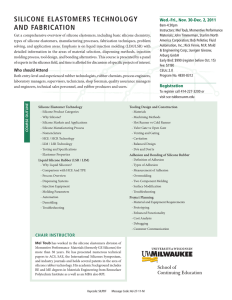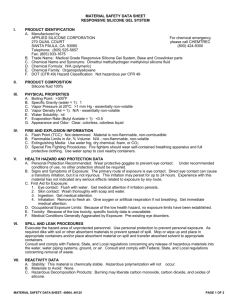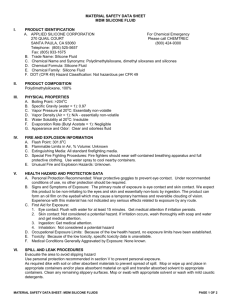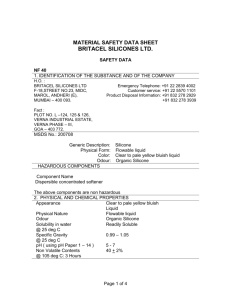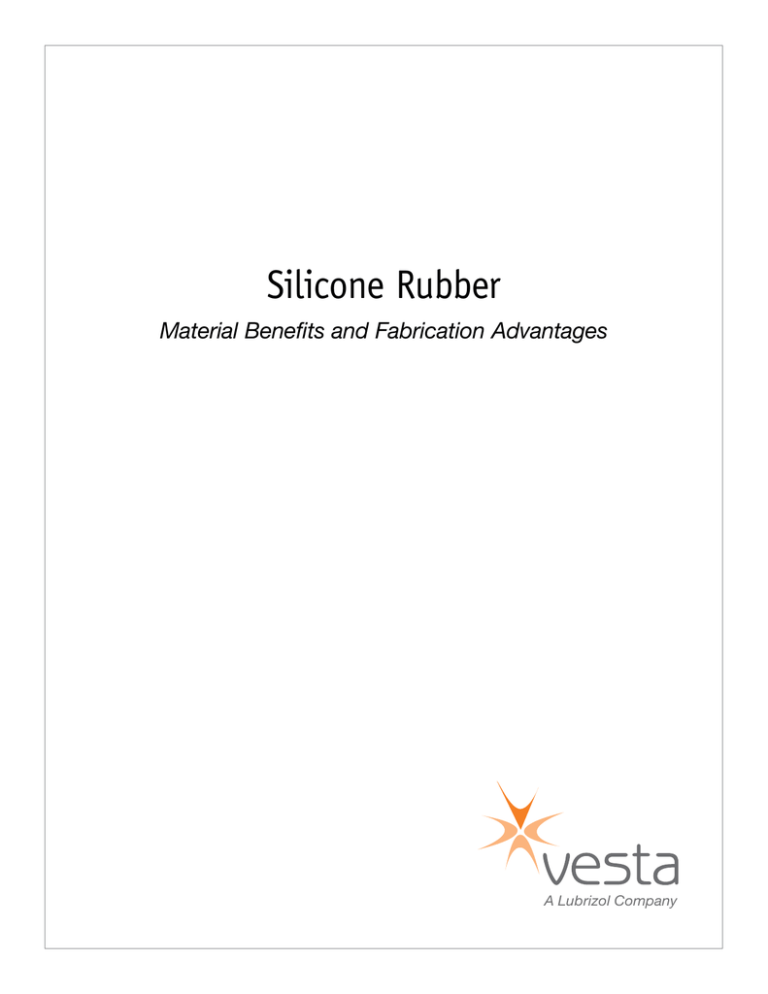
Silicone Rubber
Material Benefits and Fabrication Advantages
A Lubrizol Company
The Facts About Silicone Rubber
Selecting a high-quality elastomer for critical
applications, particularly medical devices, can be
a challenge. Designers, engineers and managers
must carefully evaluate a wide array of material
properties and processing possibilities in order
to meet demanding performance specifications
and budget requirements, so the performance
criteria must be clearly defined. For example,
durometer, elongation, modulus and tear must be
determined to specify the correct material. With so
many materials and fabrication methods available
today, it is often difficult to recognize the optimum
solution. Further, the implications of selecting an
inferior material may cause a project to fail.
To make the most informed decision, it is helpful
to gather as much data as you can about each
material. This white paper is intended to provide
you with factual information on silicone rubber
elastomers, their properties, fabrication methods
and advantages.
Silicones: Their History and Definition
CH3
CH3
Si
O
O
CH3
CH3
Si
Si
CH3
CH3
O
O
Si
CH3
CH3
Since the 1960s, silicone rubber has found widespread use in medical, aerospace,
electrical, construction and industrial applications. Flexibility over wide temperature
ranges, good resistance to compression set, a wide range of durometer selections,
and inert and stable compounds are some of the reasons for its use.
Silicone rubbers are synthetic polymers with an unusual molecular structure —
a giant backbone of alternating silicon and oxygen atoms. This linkage is similar to the
linkage found in quartz, thus silicones have superior heat resistance compared to other
elastomers. There are two popular catalyst systems used to cross-link silicon polymers:
the platinum (addition cure) systems and peroxide (free radical).
cyclic
siloxane
Alternating silicon
and
oxygen atoms
contribute to the superior heat resistance
offered by silicone rubbers.
Properties of Silicone Rubber
R
Gumstocks
are routinely extruded, as
O
they have excellent green
R
strength and will retain their
Si
shape uncured prior to
R
vulcanization.
R
Si
The strong silicon-oxygen chemical structure
of silicone gives the elastomer its unique
O
R
performance
properties. Examples include:
Si
R
Temperature
Resistance
Silicones
withstand
a wider range of temperature
cyclic silcone
extremes than nearly all other elastomers,
remaining stable through a range of -75°F to
500°F. They may be sterilized by ethylene oxide
(ETO), gamma, e-beam, steam autoclaving and
various other methods.
Liquid Silicone Rubber
(LSR)
flow is readily achieved
with little shear stress.
This flow characteristic
makes the liquid silicones
ideal for molding. They are
normally run on semi- or fully
automated liquid injection
molding machines.
extremes far higher or lower than those in
which conventional insulating materials are
able to perform.
O
Mechanical Properties
Silicone rubbers have high tear and tensile
strength, good elongation, great flexibility and a
durometer range of 5 to 80 Shore A. The softest
durometers available are reinforced gels.
Electrical Properties
Silicones exceed all comparable materials in
their insulating properties as well as flexibility in
electrical applications. They are nonconductive
and maintain dielectric strength in temperature
Biocompatibility
In extensive tests, silicone rubbers have exhibited
superior compatibility with human tissue
and body fluids, and an extremely low tissue
response when implanted, compared to other
elastomers. They do not support bacteria growth
and will not stain or corrode other materials.
Silicones are odorless, tasteless and are often
formulated to comply with biocompatibility
guidelines for medical products.
Chemical Resistance
Silicones resist water, oxidation and many
chemicals, including some acids and alkali
solutions. Concentrated acids, solvents, oils and
fuels have a negative effect on silicone rubber
and should not be used with silicone.
Overall Benefits of Silicone Rubber
Silicone rubbers are unmatched by other elastomers in many important specification categories.
Outstanding benefits of silicone include:
• Unsurpassed biocompatibility
• Ability to be sterilized by many methods
• Low compression set
• High tear strength
• High elongation
• Natural translucence or high clarity
• Ability to be pigmented and radiopacity
• Ability to retain softness indefinitely
• Long shelf life
• Processing versatility
• UV, moisture and steam resistance
• Ease of cleaning
Fabricating Silicone Rubber
Molding
LIM Steps:
1. Meter Mixing
A
B
A
B
Mixer
Mixer
AB
mix
AB
mix
2. M
old Forming and
Vulcanization
AB
mix
HEA
T
HEA
T
HEA
T
3. Final Part
Silicone elastomers are typically molded by three
main methods: liquid injection molding (LIM),
transfer molding and compression molding. The
injection molding process, an excellent choice
for high-volume applications, employs lower
pressures and higher temperatures than the other
molding methods — 250 to 2,000 psi injection
pressure and temperatures of 245°F to 485°F.
By contrast, transfer and compression molding
operate at pressures of 2,000 to 8,000 psi and
temperatures of 200°F to 370°F. In designing for
the molding process, designers should take into
account the material shrinkage rate, which can
B
range from 2% to 4%, depending Aon the material.
During molding, the three variables that must be
controlled are temperature, pressure and time.
The temperature must be optimized to ensure
Mixer
sufficient crosslinking in a minimum cure time
but low enough to prevent scorching the
elastomer. The pressure must allow complete
B
filling, maintain dimensional stability inmAthe
ix part,
prevent voids and flash. Timing of all functions
is critical for the production of consistently
acceptable, fully cured parts.
Liquid Injection Molding (LIM)
Liquid injection molding has many benefits in the
fabrication of silicone rubber, including cleanliness
and speed. In the LIM process, pumping
systems deliver the two-part liquid silicone
(catalyst and crosslinker) directly into a mixer for
homogenization, then directly into the mold cavity
in a completely closed process. Molding and
vulcanization (curing) occur rapidly within the mold
cavity at a range of temperatures.
Overall, injection can take as little as .05 to 10
seconds, while molding and vulcanization take
10 to 90 seconds or more, depending upon shot
weight and cross-section thickness.
Liquid injection molding, due to its closed process,
minimizes contamination. Additionally, because
it employs a single automated step, it provides
consistent part quality with less chance for
material mix variation.
The principal advantages of LIM include:
• Cleanliness
• No material preparation labor
• Lower injection pressure
• Faster cycle rates
• Availability of fully automated systems
Transfer and Compression Molding Using
High-Consistency Rubber (HCR) Silicones
Transfer and compression molding are widely
accepted and are in use today. Unlike the LIM
process, transfer and compression molding
require separate pre-mixing of the HCR silicone
rubber on a two-roll mill. The material is then cut
into predetermined shot size and fed into the tool
via transfer or a stuffer box.
These processes must be operated at lower
temperatures, requiring longer operating cycles.
This is why it’s not uncommon to see large molds
with 100 cavities or more on diaphragm, bottle
closure, O-ring seal and many other applications.
When transfer molding, a hydraulic ram displaces
HCR silicone through the sprues and gates into
the cavities. Compression molding differs. The
HCR silicone is manually placed into the cavities,
and it is compressed in the mold to complete the
fill during the closing action of the press.
AB
mix
Extrusion
A
B
A
B
AB
mix
AB
mix
2. Extrusion Feed
The extrusion process is able to produce
single-lumen, multilumen and coextruded
AB
mix
3. Pin and Die Profile Forming
TUBE
CROSS
SECTION
HEAT
HEAT
HEAT
The most common assembly methods
for joining multiple silicone rubber
subcomponents include insert molding
and bonding. The insert molding process
involves injection-molding liquid silicone
around an existing part or parts. The bonding
process entails joining one or more silicone
components together with silicone adhesives.
HEAT
HEAT
HEAT
HEAT
TUBE
CROSS
SECTION
There is almost no limit to the configurations
in which two or more silicone rubber
components may be joined to create
assemblies for special functions.
HEAT
TUBE
HEAT
• Reinforced tubing to provide added
strength, electrical conductivity, kink
resistance or stretch resistance
Examples of extruded silicone products
include catheters, drain and fluid path tubes,
gasketing, ribbon, sheathing, balloon cuffs
and coextruded electrical conductors, with
fluid path lumens.
Assembly
Some silicone fabricators can provide the
assembly of silicone subcomponents in
special environments, such as clean rooms
and HEPA filtered facilities, to meet OEM
cleanliness requirements.
CROSS
4.SECTION
Vulcanization
• X-ray opacity in stripe or opaque form to
provide the doctor with a visual aid
HEAT
AB
mix
• Profiles or non-round cross-sections, for
such applications as instrument stands,
clips, gaskets, seals, ties and markers
HEAT
AB
mix
HEAT
1. Mill Blending
tubing in a variety of properties and
diameters. Other extrusions include:
HEAT
The HCR silicone extrusion process yields
a broad range of tubing and profiles. The
extrusion process begins with the two-part
HCR silicone (catalyst and crosslinker) being
blended on a two-roll mill. The blending
yields a homogeneous compound that is
formed into strips and fed continuously
into the extruder. A feed screw maintains
proper pressure at the pin and die. Once
extruded, the tubing passes through hot-air
vulcanization ovens (HAVs), where radiant
heat cures the product. During the extrusion
process, laser micrometer checks are
performed to continuously ensure proper
dimensional control.
HEAT
Extrusion Steps:
Other methods include tipping, reinforcing,
dipping and cuffing.
Silicone rubber assemblies can include
airways, shunts, occluders, laparoscopic
devices and many others.
Secondary Operations
Full-service silicone fabricators provide a
range of secondary operations to satisfy
specialized product requirements:
• Silk screening
• Slitting
• Punching
• Beveling
• Bundling
• Functional testing
A multi-component assembly — This catheter
Silicone Balloon
began with a molded or extruded tube,
internally reinforced with a stainless steel
Reinforced Spring
spiral wire. The wire, specified by the customer
to provide kink resistance, was inserted into the
mainshaft I.D. and then encapsulated. Next, a
Molded Tube
molded balloon was bonded onto the distal
Check Valve
end. The tip of the mainshaft was beveled and
coated for ease of insertion. The check valve assembly
was then attached through bonding for cuff inflation. The assembly also has several secondary processes,
including holes pierced in the sidewalls for drainage and printing on the side for identification.
Silicone Rubber Comparative Analysis
When Compared To...
Silicone Material Delivers...
Latex
• Lot-to-lot consistency due to controlled synthetic process,
vs. organic lot-to-lot variations
• Superior biocompatibility
• Higher clarity
• Better electrical insulation properties
• Stability over a broader temperature range
PVCs
• Inertness and absence of leachable additives
• Superior biocompatibility
• Stability over a broader temperature range
• Superior sterilization properties
Polyurethanes and Vinyls
• Plasticizer- and toxin-free
• Superior biocompatibility
• Broader temperature stability
• Lower compression set
• Better clarity
• Greater softness
TPEs
• Superior biocompatibility
• Superior chemical resistance
• Lower durometer
• Lower compression set
Applications
Silicone rubber components and assemblies are employed in a wide range of applications, including:
• Ear plugs / hearing aids
• Electrosurgical handpieces
• Feeding devices and tubing
• Wire / fluid path coextrusions
• Power supply cables
• Infusion sleeves / test chambers
• Introducer tips / flexible sheaths
• Airway, endotracheal tubes, with and
without cuffs
• Drainage catheters, with and
without balloons
• Compression clips and standoffs
• Delivery catheters with and without cuffs
• Drainage tubes, all shapes and sizes
Commonly Fabricated Parts
Pilot Balloon
Reinforced Tube
Bolster
3-Lumen Catheter
Flat Drain
Bellows
Precision Pump Tube
Shunt
Making the Decision
When evaluating silicone rubber as a potential material
for your part, consider your possible need for design
assistance, prototyping, cost effectiveness and testing
requirements. While silicone rubber may have a higher
per-pound cost than other common elastomers,
consider the superior end results along with tooling,
prototyping and manufacturing efficiencies that
can help you realize substantial savings. Once you
determine that silicone rubber is the right material for
your part and select a fabrication process, consider
the following qualifications when choosing a
silicone fabricator:
Engineering and Design
Is the potential fabricator well-staffed with experienced
engineers who can help you refine your concepts
and design the custom tools to produce them? What
prototyping methods are available? Are they able to
do the secondary operations required?
Materials Expertise
Does the fabricator have the expertise and experience
to help you choose the proper silicone compound for
your application? Are engineers available to help you
evaluate the physical specifications of your product
and determine the optimum process parameters?
Are they able to supply the proper grade silicones
for your application?
Manufacturing Capabilities
Does the fabricator maintain QSR-controlled
manufacturing facilities? Is the fabricator equipped
for short or long runs, low or high volumes? Does
the fabricator have advanced molding and extrusion
equipment, including LIM and HCR equipment? Do
they offer assembly, secondary, wash and packaging
operations? If cleanliness is an important specification
for your part, does the vendor have a controlled
environment for its manufacturing area?
Quality
Does the supplier practice audited quality control
production? Maintain advanced inspection equipment
such as video microscopes and laser micrometers?
Perform raw material testing, in-process inspection,
SPC and end product testing? Provide 100%
inspection when specified?
About Vesta, Inc.
Vesta is an ISO 13485 certified contract
manufacturer providing molding, extrusion and
assembly services to support the global medical
device industry. Vesta is recognized for its expertise
in design assistance, material selection and
compliance to quality standards. Molding capabilities
include liquid injection, transfer and insert molding
of medical grade silicone. Vesta’s ExtruMed™
Vesta, Inc.
9900 57th Street
Franklin, WI 53132 U.S.A.
Tel:414.423.0550
Fax:414.423.0562
sales@vestainc.com
www.vestainc.com
GC 150850
SEPT 2015
Copyright © 2015 Vesta, Inc. All rights reserved.
precision solutions utilize thermoplastics and silicone
for a wide range of tubing and tight-tolerance
extrusion applications, with special capabilities in
braiding, balloon blowing and PEEK extrusion. Vesta
capitalizes on 40 years of experience in helping the
top medical device companies launch their products
with success. Find more information about Vesta’s
complete solutions at www.vestainc.com
A Lubrizol Company

